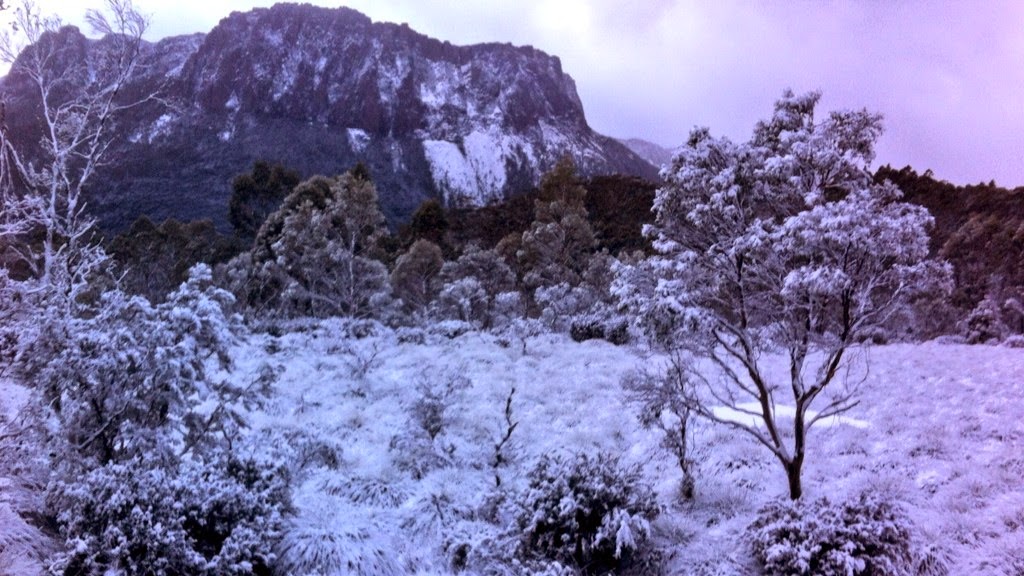Top 5 new walks for 2015
Whether completely new experiences offered this year, or new walks for me, this is my top 5 list completed over 2014. If you get a chance, do them in 2015!
 |
| Devils Marbles, NT |
I've been blessed this year to spend time in every Aussie state except SA, so apologies to SA - hope to get there next year!
1. Overland Track, mid-winter
 |
| Fellow walker on Overland Track, mid-winter. |
No contest for my favourite walk this year – the Overland Track in mid-winter. Yes, the Overland Track has been around for a long time, and I've done bits of it before, but never in winter with snow bucketing down for two days, and climbing up ice to reach the summit of Mt Ossa. For the first year ever, the wonderful Cradle Mountain Huts, now run by the Tasmanian Walking Company, were thrown open for a trial winter walk. It was an absolute cracker, and ended up being one of my best photo shoots ever (see story and images in Outback magazine), with frozen waterfalls, ice, sun, driving rain and snow. Despite the fact that we had to evacuate one of our party by helicopter on the second morning, the trip was deemed a roaring success, and it will now be offered next year. My advice, if you have never done the Overland Track, or even if you have, sign up for the experience. And not just for the warm stove and crackerjack meal that's cooked for you at the end of the day - the walking is stunning.
2. Marvelling at the Marbles
 |
| Round and round you walk. |
3. Kooljaman, Cape Leveque
 |
| Look at those colours! Kooljaman Wilderness Safari Camp. |
The featured bright red cliffs towering over white sand at Kooljaman, north of Broome, WA, have been featured in zillions of photos, and rightly so. But on the other side of Kooljaman Wilderness Safari Camp, heading up the coast, a little sand track that winds past the solar farm passes one of the most amazing middens I've ever come across. Like I imagine most middens used to be, it is riddled not just with shells, but with stone tools used to open the shells. I wandered around it for quite some time amazed that such a special site so close to a resort has been (thankfully) left so untouched. Please, if you go there, do not take anything away from this special place. (Apologies, most of my photos from this trip have not been published yet so I can't put them in here.)
4. Scenic Rim Trail, southern Qld
 |
| Climbing the cool mountains of Qld on the Scenic Rim Trail. |
Another one for those who like walking, but also like a bit of luxury with it, this is a brand new three-night walking experience from Spicers. The walk, which is in the cooler mountains of Queensland, includes some energising uphills and some of the most beautiful ancient hoop pine forest I've ever seen, but the real highlight is staying both at Spicer's Canopy retreat, in sumptuous safari tents, and then at the luxurious Spicers Peak Lodge, where you are treated to a seven-course degustation dinner, spas and divine views.
 |
| And this is what awaits on the last night: Spicers Peak Lodge. |
5. Walking around Mecca
Okay, I'm showing my bias here, and maybe non rock-climbers will question this. But it was such a joy to get to the Mecca of Australian rock-climbing, Mt Arapiles in western Victoria. This wonderful spot has thousands of climbs just a few minutes walk from the campsite, but it also offers extensive views and wildlife galore. There are walks around and up the mountain, and well worth dropping in there for a walk (but probably not in the heat of summer). |
| Mt Arapiles, showing The Pines campground in the background. |
I'm definitely looking forward to a lot more exploring and walking in 2015, including, hopefully another new walk experience that hasn't received much publicity yet – the sail/walk Wineglass Bay trip put on by the Tasmanian Walking Company. Keep an eye out too for the new Three Capes Track, also in Tasmania, that will hopefully be finished in 2015.
See you on the track.
www.kensbigbackyard.com.au































.JPG)





